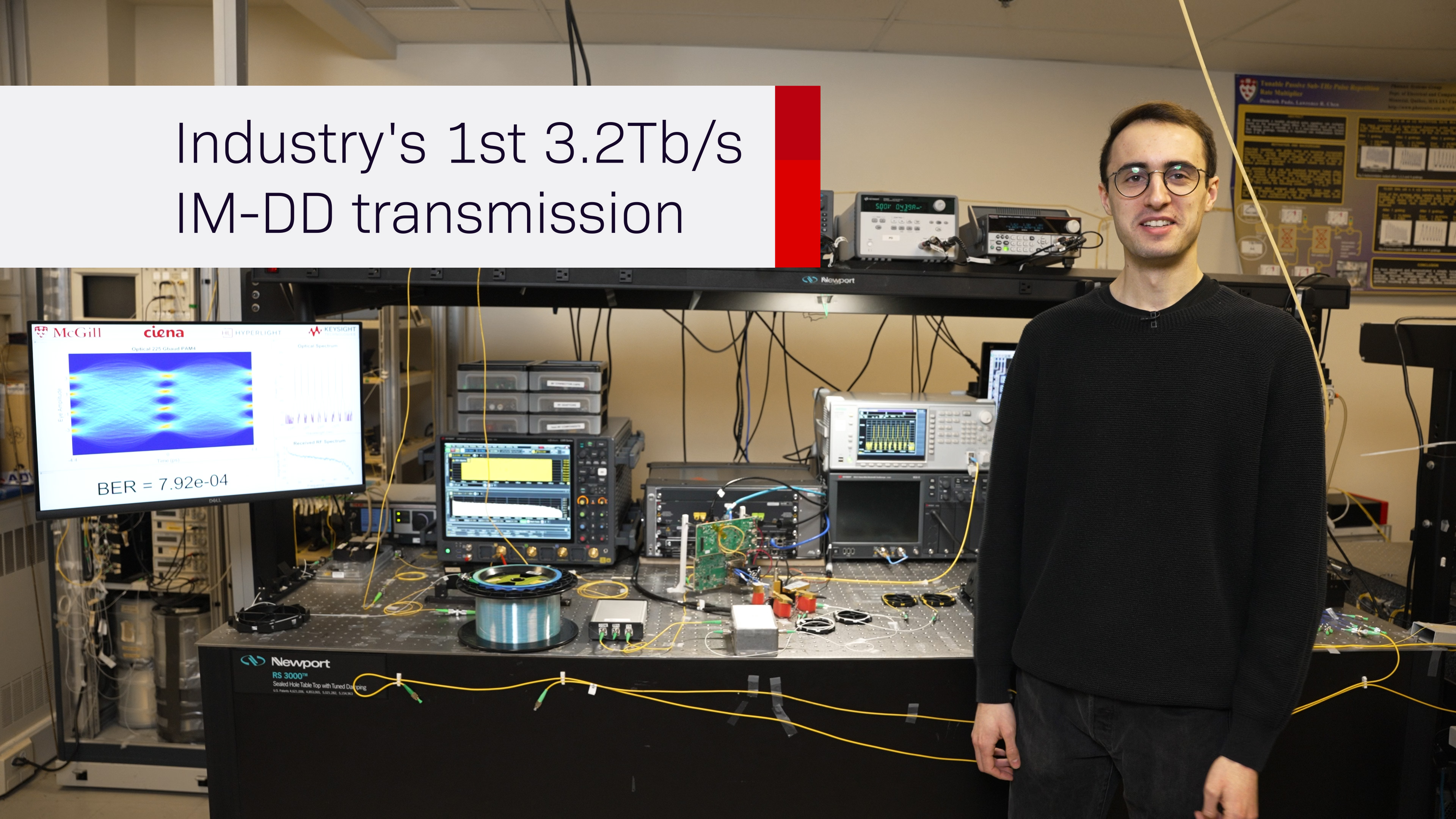Digital sustainability: calculating the green impact of coherent technology innovations
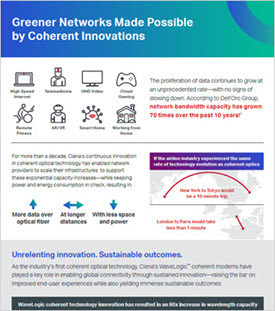 If 10 years ago you had told a network planner that they would one day be sending 800G/s across their networks – their response might well have been, “well then we are going to need a much bigger data center.” How has this been avoided? The answer: unrelenting coherent technology innovation.
If 10 years ago you had told a network planner that they would one day be sending 800G/s across their networks – their response might well have been, “well then we are going to need a much bigger data center.” How has this been avoided? The answer: unrelenting coherent technology innovation.
We often tie these incredible advancements in coherent optical technology over the past decade to the enablement of new high bandwidth applications and services, transport cost reduction, and network scalability. And rightly so. Without these innovations, we would not be living in this digital world we live in today, with the ability to communicate and access any content we want, on-demand and from any location.
Another less commonly discussed but important outcome of coherent innovations has been continual and significant reduction in footprint and power required for each generation of technology introduced, enabling the evolution to greener networks. This innovation has made a measurable and tangible impact in helping the environment and the reduction of global emissions. How much?
Network providers deploying Ciena systems have been able to avoid over 3 million metric tons of Carbon Dioxide emissions while still meeting capacity demands.
The details behind the calculations
According to Dell’Oro Group, bandwidth capacity in the network has grown an incredible 70 times over the last 10 years.1
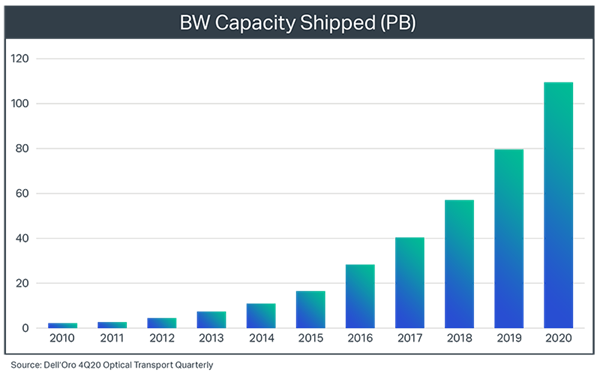
Coherent technology has played a critical role in helping network providers address this 50% year-over-year growth in bandwidth demands that they have been facing, while at the same time simplifying the network. If we look at the evolution of DWDM hardware over time, the industry has been able to achieve an 80 times increase in data throughput over a single wavelength (i.e., a single pair of transceivers), all in the same or smaller footprint!
This also means that there are fewer watts per bit needed for each gigabit shipped. We have seen a 90% reduction achieved in power per bit consumption for optical transmission.
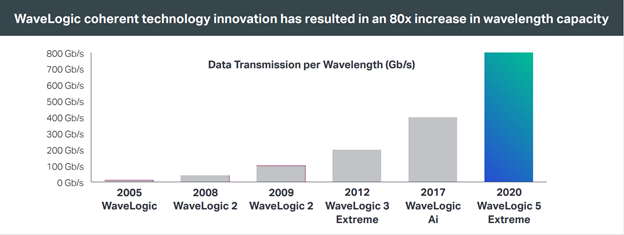
Ciena has been at the forefront of this innovation. We were first to market with coherent DWDM in 2008, offering 40Gb/s, 1st with 100Gb/s in 2009, 1st with 400Gb/s in 2017, and most recently, 1st with 800Gb/s in 2020. Being first to market with the new technology means our customers can realize the benefits of networking efficiencies earlier.
A key benefit of the technology innovation has been allowing providers to repurpose existing fiber plant to carry more capacity and delay the need to lay out new fiber. How much more? Over the past decade, coherent technology innovations have allowed for a 20 times increase in total fiber capacity. Put in other words, a network provider can carry 20 times the amount of data on their network today (using the same C-band optical spectrum) versus what they could carry 10 years ago using 10G DWDM.

A visual example is shown below of the impact on capacity, space, and power efficiencies gained with coherent technology innovation over the last three generations of Ciena’s WaveLogic coherent optics implemented on our Waveserver platform. Being able to deploy 400Gb/s wavelengths for long distance applications results in 75% increase in fiber capacity, 87.5% footprint savings, and 80% power savings versus deploying 100Gb/s wavelengths. Network operators can do more with less, enabling important energy consumption savings.
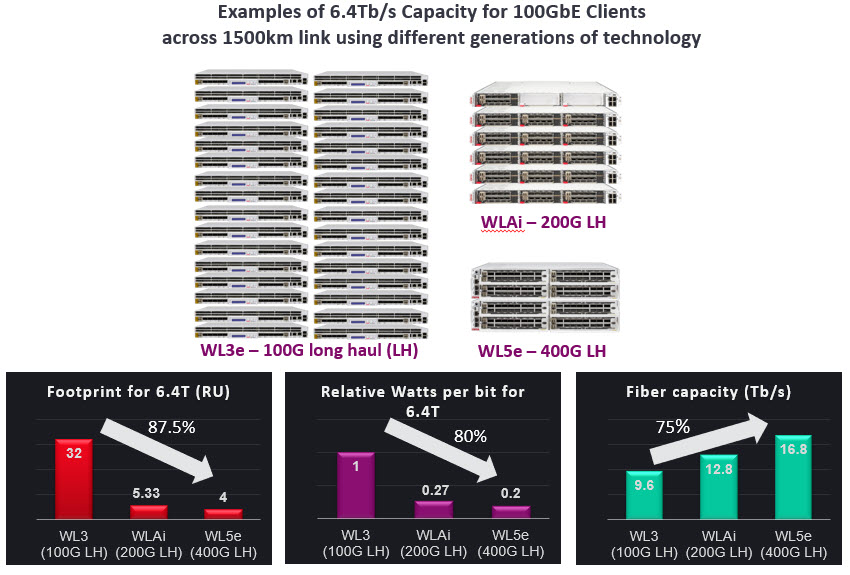
Net impact of coherent technology innovation to the environment
Excluding China, Ciena is the leading global supplier for optical capacity with our systems. To understand the value of technology innovation in enabling a more sustainable environment, we analyzed all capacity shipments from 2010 to 2019 across all WaveLogic generations and calculated the power consumption associated with the hardware that was shipped. We then calculated power consumption to satisfy these same capacity demands solely using hardware from 2010.
The net direct impact of WaveLogic technology innovation has been to save more than 3 million metric tons of carbon from having been emitted into the atmosphere in realizing the capacity required with Ciena systems.
Based on the EPA’s website, this is equivalent to >3.4 billion pounds of coal burned:
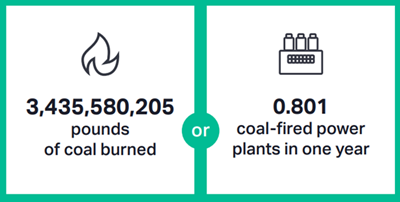
or equal to the carbon sequestered by over 4 million acres of US forests in one year:
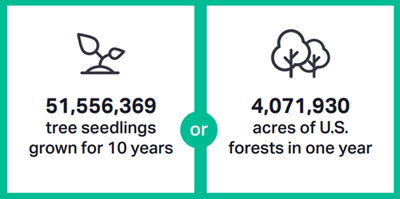
How has Ciena been able to achieve these results with our platforms? It boils up to four proficiency areas:
- By implementing new, innovative Digital Signal Processing (DSP) including novel coding techniques and sophisticated Forward Error Correction (FEC) algorithms,
- Leveraging the latest generation of CMOS technology for each succeeding WaveLogic generation, allowing for increased levels of functional integration in the DSP ASIC
- Investing in continued improvements in electro-optic miniaturization, leveraging photonic integration with both silicon photonics and Indium Phosphide materials, and last but not least,
- Innovating across a committed cross-functional team, with expertise ranging from high-speed photonics component design, DSP ASIC design, high-speed analog design, digital communications and optical propagation experts.
At Ciena, we are committed to helping our customers with all their business needs. That doesn’t just mean delivering higher capacities to meet critical connectivity demands, it also means investing our resources to drive innovation for new efficiencies to enable greener networks. And we are not stopping here. Our WaveLogic 5 Nano technology available in 2021 is design-optimized for lowest power and smallest footprint, delivering additional dramatic improvements in environmental efficiency, with a further 50%+ reduction in power/bit versus previous technologies.
Want to learn more? Click on the infographic below to get more details.






